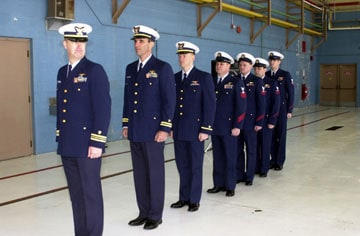Admiral Chester R. Bender became Commandant of the U.S. Coast Guard in 1970. He felt that the Coast Guard should create a distinctly different uniform from that of the Navy and solidify the fact that the Coast Guard was a separate organization. Admiral Bender also felt that the traditional bluejacket enlisted uniform was demeaning for older enlisted personnel and that it detracted from the authority of petty officers engaged in law enforcement duties. A board was established to consider the uniform change. Retaining the Navy uniform was not an option. The board proposed a uniform similar in style to the old Surfman’s uniform. The distinctive color was suggested by the Army’s Nattic Research Laboratory as it was different from any other military or government service. The board recommended an enlisted uniform similar to that proposed for officers.
The Commandant circulated a questionnaire and photographs of the newly designed uniform throughout the service. The reaction by the enlisted personnel was very favorable but the proposed uniform was not popular with the majority of the officers. This was especially true in the aviation ranks as it spelled the end to the distinctive aviation greens and the leather jackets.
 The Coast Guard Blue uniform was approved by the Secretary of Transportation John A. Volpe in 1972. It was several years in getting to the field and would be lamented by some for a considerable time afterward. The uniform became known as “Bender Blues.”
The Coast Guard Blue uniform was approved by the Secretary of Transportation John A. Volpe in 1972. It was several years in getting to the field and would be lamented by some for a considerable time afterward. The uniform became known as “Bender Blues.”
In 1915 the Revenue Cutter Service and the Life-Saving Service combined to form the U.S. Coast Guard. The new service soon had its distinctive uniform characteristics.
By the 1920s major changes were seen in Coast Guard uniforms. First was the adoption of the double-breasted service coat similar to that still worn by the U.S. Navy. This was worn without shoulder straps, and rank designations were on the lower sleeve, with the familiar shield device above the rank stripes. Enlisted men, below petty officer, adopted the Navy-style white duck hat, though the traditional Donald Duck flat cap remained standard. The vessel name on the hat ribbon was to read, for example: U.S.S. Manning, C.G.
Coast Guard aviation came in to being in 1916. Aviators of this period flew and worked in their uniforms. The Navy had established a uniform for aviators that was “much more practical around the grease and dirt of flying machines.” The Marine Corps uniforms were adapted to aviation. In keeping with Marine Corps custom, brown shoes were worn. Thus aviators became known as “Brown Shoes” and the surface Navy as “Black Shoes.” The working dress for aviators, all ranks above petty officer, was forest-green gabardine or serge for winter and khaki-colored cotton for summer. The jacket had three buttons, a rolling collar with notch lapel, and four outside pockets (the lower to be of the bellows style). The pockets had flaps and the back had a bellows pleat from the shoulder to the sewn in waist belt. Green shoulder boards with black rank and shield devices were worn with the winter uniform. The khaki shirt had a soft collar worn with a black tie. The aviator badge was a winged, fouled anchor with shield, worn on the left breast. A folding-type flying cap was also authorized, edged in black and gold silk for commissioned and chief warrant officers. In 1941, Chief petty Officers designated as Naval Aviation Pilots were also authorized to wear the aviation uniform.
In 1941, for the first time, Coast Guard uniforms became officially a modification of Navy regulations. The garments themselves were the same as Naval uniforms and included the khaki undress combination with sewn in belt. Both services used the “combination cap”: the officer’s peaked headgear with interchangeable covers to match khaki, white or winter uniforms. Only the distinguishing corps devices, buttons, shoulder marks, etc., were distinctively Coast Guard. The officer’s cap device for the Coast Guard was the most obvious difference. It consisted of a large spread eagle with shield, with a single horizontal anchor held in the eagle’s talons. The Naval device had, and still has, a smaller eagle over crossed anchors. Also, the Naval eagle was silver; the Coast Guard’s, gold.
The Coast Guard uniform coat also continued to have the national shield placed above the sleeve rank stripes. Coast Guard gilt buttons centered their design on a perpendicular anchor, with a rope like inner-rim. The Naval button consisted of an eagle, facing Dexter over a horizontal anchor.
It should also be noted that the Coast Guard accompanied the Navy in the short-lived adoption of a grey undress uniform. This uniform, which was a dark steel grey, cut in the khaki single breasted pattern, was to be a cost-cutting replacement for both the khaki and double-breasted navy blue (black) uniforms. As with the other uniforms, it was complete with a grey cover for the combination cap. It was adopted in 1943 and phased out in 1947, when it became obvious that the Navy was not interested in abandoning the double-breasted uniform.
The interchangeability with Navy uniforms continued until after the transfer of the Coast Guard to the Department of Transportation and the subsequent adoption of today’s lighter blue, single-breasted uniform. The present enlisted uniform marked the first major change in enlisted men’s uniforms in over a century. Today, the only uniforms still identical to the navy’s are the officer’s summer white service and full dress combinations.

